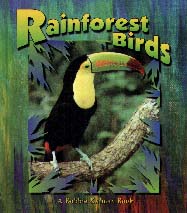|
________________
CM . . . .
Volume V Number 13 . . . . February 26, 1999
If you are looking for a book to help young people discover facts and
colourful pictures of rainforest birds, this is a very useful source. With
its "Words to know" (glossary) and a somewhat detailed index,
Rainforest Birds provide readers with insights into a great variety
of birds of the jungle.
Unfortunately, the index is "spotty" in its efforts to lead the reader to
certain types of birds. It is quite possible that young readers would have
difficulty finding any information on "Motmots" or on "Ocellated turkeys"
in other sources. A glance at the index to this book would not satisfy a
reader, as the editors have chosen NOT to include these birds, even though
they are referred to in the text. Only by browsing through the book could
the reader hope to find the information on these two birds.
Another disturbing technicality is the use of highlighted words throughout
the text. Although there is no explanation of why some words are
highlighted, there appears to be some link to the glossary; however, this
is not always so. The writers and editors have chosen, on several
occasions, to define terms within the paragraph, or parenthetically, so
there is no need for a glossary entry. Other terms, undefined in text, may
be highlighted, but they do not appear in the glossary either, and, hence,
are left entirely undefined. For example, the word "lek" appears
(highlighted) on page 11 and is referred to in the text as an "area."
Readers hoping to find some further definition in the glossary arrive at a
dead end as the word does not appear there. Incidentally, "lek" is not
included in the index.
Besides the inherent confusion in the use of
the index and glossary, there is a disturbing inconsistency in the way singular
and plural antecedents are mixed in some sentences. For example, on page 13,
the writer uses "sunbirds have a thin, tubelike beak ..." This might have been
more clearly stated by using the singular "A sunbird has a ... beak", or the
plural, "Sunbirds have ... beaks." Mixing singular and plural antecedents is
confusing and provides a poor model for young readers. Another example, on p.
21, states, "Kingfishers grab a fish with their beak." It seems to mean that
several different kingfishers grab several different fish using several
different beaks, but that is not what it says. Even a chapter title illustrates
this "agreement" problem; "Losing their home," on page 30 introduces a
paragraph which outlines how many species are losing their "homes." In fact, on
page 31, a sentence reads, "When a rainforest is cut down, all the animals and
birds living in it lose their homes, ...". This is quite correctly stated, a
clear indication that there are inconsistencies of expression. (This type of
inconsistency appeared in the other two books in this series which this
reviewer studied
Raptors and Marine
Birds.)
The reviewer was unable to determine why the editors chose to highlight
the first letter of several words in the index. Despite the technical
shortcomings of this book, its content warrants its inclusion in any
library serving elementary school children.
Recommended.
Bob Piper is a semi-retired teacher-librarian who lives in Winnipeg, Manitoba.
To comment on this
title or this review, send mail to cm@umanitoba.ca.
Copyright © the Manitoba Library Association.
Reproduction for personal use is permitted only if this copyright notice
is maintained. Any other reproduction is prohibited without
permission.
Published by
TABLE OF CONTENTS FOR THIS ISSUE - FEBRUARY 26, 1999.
AUTHORS |
TITLES |
MEDIA REVIEWS |
PROFILES |
BACK ISSUES |
SEARCH |
CMARCHIVE |
HOME
|

